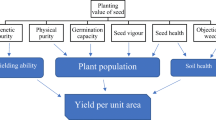Abstract
This review presents an analysis of nanoagents developed in research and academic institutions of Russia which are used as aqueous suspensions and colloidal solutions containing nanoparticles of metals (Fe, Cu, Co, and Ag) and nonmetals (phosphorus, silicon, selenium, and bischofite) ranging in size from 1 to 100 nm. The main method of seed treatment is soaking. As a rule, treatment with nanoagents has a positive effect on germination and yield. Cereals were used as the main experimental crops. The review summarizes results from the treatment of vegetables and oilseed crops. The yield increase ranged from 0.4 to 45 metric centner per hectare; the seed germination rate increased in the range of 10–20%. After treatment with nanoagents, some improvements in the biochemical composition of crops are observed.
Similar content being viewed by others
References
G. P. Gamzikov, “Agrochemical problems in modern agriculture,” Innov. Prod. Bezopasn. No. 1, 88–100 (2013).
E. M. Popov, “Ecological-economical grounding of promising development of technologies based on the most common nanoparticales application,” Nauchn. Vestn. Mosk. Gos. Gorn. Univ., No. 11, 194–198 (2013).
S. D. Polishchuk, A. A. Nazarova, and M. V. Kutskir, “Fertility and biochemical composition of sunlower if seeds are processed by copper nanoparticles,” Vestn. Ryazansk. Gos. Agrotekhnol. Univ. im. P. A. Kostycheva, No. 2, 104–106 (2013).
Yu. N. Ivanycheva, T. V. Zheglova, and S. D. Polishchuk, “Copper nanopowders and copper oxide effect onto phytohormones activity at Vicia and summer wheat sprouts,” Vestn. Ryazansk. Gos. Agrotekhnol. Univ. im. P. A. Kostycheva, No. 1, 12–14 (2012).
S. D. Polishchuk, A. A. Nazarova, M. V. Kutskir, and D. G. Churilov, “Biologically active agriculture preparations based on biogenic metals nanoparticles,” in Proc. 9th Sci.-Pract. Conf. “Nanotechnologies for the Industry” (Fryazino, Apr. 10–12, 2013), pp. 56–57.
L. S. Nazarova, V. A. Nazarov, I. V. Nazarov, D. I. Bilenko, G. A. Kutuzova, and T. A. Protsenko, Effect of Chemical Elements in Ionic and Nano Form onto Prokaryotes and Eucaryotes (Saratov State Vavilov Agrarian Univ., Saratov, 2011) [in Russian].
E. A. Smirnova, A. A. Gusev, O. N. Zaitseva, E. M. Lazareva, G. E. Onishchenko, E. V. Kuznetsova, A. G. Tkachev, A. V. Feofanov, and M. P. Kirpichnikov, “Carbon nanotubes penetrate in cells and stimulates Onobrychis Arenaria sprouts,” Acta Natur. 3 (1), 106–113 (2011).
A. R. Rodin and E. A. Kalashnikova, “Theoretical and practical aspects of nanotechnology application during seeds pre-seeding treatment,” Lesnoi Vestn., No. 7, 65–66 (2012).
V. F. Ladonin and A. M. Aliev, Complex Application of Herbicides and Fertilizers for Intensive Agriculture (Agropromizdat, Moscow, 1991) [in Russian].
D. G. Churilov, M. N. Gorokhova, G. I. Budarina, S. D. Polishchuk, and I. V. Bakunin, “Features of corn and sunflower growth if seeds are processed by cobalt nanoparticles,” Trudy GOSNITI, 46–48 (2011).
N. V. Zabegalov and E. V. Dabakhova, “Effect of silicon containing nanopreparation onto fertility and silicon content in cereals,” Dostizh. Nauki Tekhn. Agroprom. Kompleksa, No. 12, 22–24 (2011).
S. D. Polishchuk and A. A. Nazarova, “Microfertilizers based on metals nanoparticles for seeds pre-seeding treatment,” in Nanotechnological Developments Performed by Agriculture Universities (Scientific Research Institute — Federal Research Centre for Projects Evaluation and Consulting Services, Moscow, 2013), pp. 12–17 [in Russian].
A. Kh. Yapparov, N. Sh. Khisamutdinov, and I. D. Valiev, “Effect of nanostructures aqua-phosphate suspension onto yield and agrochemical indexes of grey forest soil used for corn growth,” in Proc. 4th Int. Kazan Innovative Nanotechnological Forum “NANOTECH 2012” (Kazan, Nov. 27–29, 2012), pp. 321–324 [in Russian].
A. Kh. Yapparov, N. Sh. Khisamutdinov, and I. D. Valiev, “The way to apply nanostructured aquaphosphate suspension as a fertilizer for corn breeding for herbage,” in Proc. 4th Int. Kazan Innovative Nanotechnological Forum “NANOTECH 2012” (Kazan, Nov. 27–29, 2012), pp. 349–350 [in Russian].
A. Kh. Yapparov and N. L. Sharonova, “Efficiency of nanostructured aqua-phosphate suspension application for growing cucumbers at protected ground,” in Proc. 4th Int. Kazan Innovative Nanotechnological Forum “NANOTECH 2012” (Kazan, Nov. 27–29, 2012), pp. 317–319 [in Russian].
S. G. Azizbekyan, A. R. Nabiulin, and V. I. Domash, “Efficiency of fertilizers based on bioelements nanoparticles,” Nanotekhnika, No. 4, 70–71 (2012).
L. E. Ampleeva, A. A. Kon’kov, A. V. Rudnaya, and S. N. Gaglova, “Effect of selenium nanoparticles suspension onto growth, development and yield indexes of “Sante” potato,” Vestn. Ryazansk. Gos. Agrotekhnol. Univ. im. P. A. Kostycheva, No. 2, 47–50 (2011).
G. I. Churilov, “Metals nanopowders effect onto water saluted polysaccharides of medical plants,” in Proc. 9th Sci.-Pract. Conf. “Nanotechnologies for the Industry” (Fryazino, Apr. 10–12, 2013), pp. 88–89.
G. I. Churilov, “Effect of ferrum, copper and cobalt nanopowders in plant-soil system,” Vestn. Orenburg. Gos. Univ., No. 12, 148–151 (2009).
S. D. Polishchuk, G. I. Churilov, and T. V. Zheglova, Nanomaterials Effect onto Structure and Properties of Water Soluble Polysaccharides of Medical Plants (Ryazan, 2010) [in Russian].
Z. I. Usanova, I. V. Shal’nov, N. N. Ivanyutina, T. I. Sutyagina, and N. V. Babich, RF Patent No. 2463757 (2012).
G. E. Folmanis and L. V. Kovalenko, “Colloid selenium intended for crop growing,” Nanotekhnika, No. 3, 77–80 (2012).
Yu. G. Folmanis, “Nanomaterials intended for biofuel growing,” Molodoi Uchenyi 2 (4), 164–166 (2011).
A. A. Vasil’ev and V. S. Kozhemyakin, What we need to know on potato? http://chel-potatoes.ru/content/view/172/7
S. D. Polishchuk, A. A. Nazarova, S. G. Azizbekyan, and V. I. Domash, “Biological efficiency of nanopowders and colloids,” in Proc. 9th Sci.-Pract. Conf. “Nanotechnologies for the Industry” (Fryazino, Apr. 10–12, 2013), pp. 22–23.
M. V. Kutskir, A. A. Nazarova, and S. D. Polishchuk, “Effect of different types of copper based microfertilizers onto physiological, biochemical and productive indexes of summer wheat,” in Proc. 7th Int. Symp. on Fundamental and Applied Sciences (Russ. Acad. Sci., Moscow, 2012), pp. 132–152 [in Russian].
Author information
Authors and Affiliations
Corresponding author
Rights and permissions
About this article
Cite this article
Fedorenko, V.F., Buklagin, D.S., Golubev, I.G. et al. Review of Russian nanoagents for crops treatment. Nanotechnol Russia 10, 318–324 (2015). https://doi.org/10.1134/S199507801502010X
Received:
Accepted:
Published:
Issue Date:
DOI: https://doi.org/10.1134/S199507801502010X




